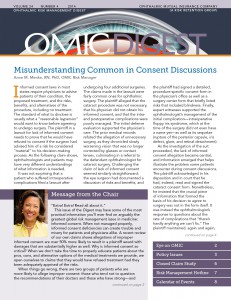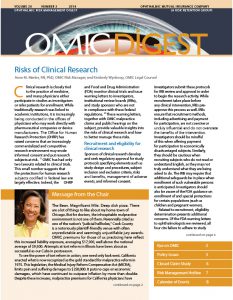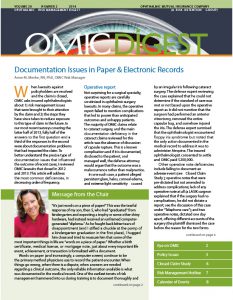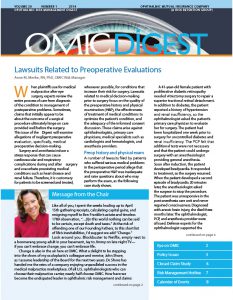OMIC Digest Archives 2014
Documentation Issues in Paper & Electronic Records
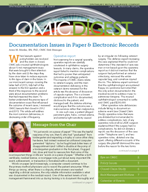 Anne M. Menke, RN, PhD, OMIC Risk Manager
Anne M. Menke, RN, PhD, OMIC Risk Manager
When lawsuits against policyholders are resolved and the claim is closed, OMIC asks insured ophthalmologists about 1) risk management issues that were brought to their attention by the claim and 2) the steps they have since taken to reduce exposure to this type of claim in the future. In our most recent surveys covering the latter half of 2013, fully half of the answers to the first question and a third of the responses to the second were about documentation problems that had impacted the claim. To better understand the precise type of documentation issues that influenced the outcome of recent cases, I reviewed OMIC lawsuits that closed in 2012 and 2013. This article will address the most common deficiencies, in decreasing order of frequency.
Operative report
Not surprising for a surgical specialty, operative reports are carefully scrutinized in ophthalmic surgery lawsuits. In many claims, the operative report failed to mention complications that led to poorer than anticipated outcomes and unhappy patients. The majority of OMIC claims relate to cataract surgery, and the main documentation deficiency in the cataract claims reviewed for this article was the absence of discussion of capsule rupture. This is a known complication and if it is documented, disclosed to the patient, and managed well, the defense attorney would argue that the outcome was a maloccurrence rather than malpractice.
In one such case, a patient alleged persistent glare, halos, corneal edema, and extreme light sensitivity caused by an irregular iris following cataract surgery. The defense expert reviewing the case explained that he could not determine if the standard of care was met or not based upon the operative report as it did not mention that the surgeon had performed an anterior vitrectomy, removed the entire capsular bag, and somehow injured the iris. The defense expert surmised that the ophthalmologist encountered floppy iris syndrome but noted that the only action documented in the medical record to address it was to administer Atropine. The insured ophthalmologist consented to settle and OMIC paid $200,000.
Other operative note deficiencies include failing to document an adverse event (see Closed Claim Study); operative notes that were pre-dictated but not amended to address complications; lack of any operative note at all (a LASIK surgeon explained that if the surgery had no complications, he did not dictate a report; see the discussion of this case under “Telephone care”); and two operative notes, dictated one day apart, offering different accounts of the surgery (the plaintiff dismissed the case before the reason for the two forms could be explored; defense counsel felt they would have posed problems for a successful defense).
Preoperative decision-making
Complications arising from surgical care would not have happened if the surgery had never taken place. Attorneys representing patients thus review the preoperative decision-making process carefully to determine if the surgery was indicated. In one case, a patient who experienced irregular astigmatism after implantation of a premium toric intraocular lens filed a claim. The defense expert felt that the surgery was indicated and had no concerns about the intra- or postoperative care, but questioned why the preoperative evaluation did not include keratometry, topography, or refractions from the patient’s recent preoperative visits, which would have helped assess the amount and type of astigmatism prior to surgery. The patient did not pursue the claim and it closed without payment.
In another case, a patient sued after developing diplopia and excessive scarring when a lid lesion was removed. One defense expert felt that the scarring could not have been anticipated and that the patient had experienced a rare, idiosyncratic immune response. Another defense expert, who sees many patients with the same type of benign lesion, questioned the need to remove it. He also criticized the lack of documentation about why the surgeon decided to excise it, as the record did not contain any patient complaints about problems the lesion was causing. With the consent of the insured ophthalmologist, the case settled for $95,000.
Informed consent
The adequacy of the informed consent discussion is often challenged in lawsuits. It is more difficult to obtain informed consent when the patient has limited English proficiency. In one of the cases reviewed, a Spanish-speaking patient had cataract surgery complicated by posterior capsule rupture and anterior vitrectomy. He sued after losing all vision following a postoperative retinal detachment. The only consent form found in his medical record was for a clinical trial in which he was not a subject, and there was no documentation about the use of a translator during the informed consent discussion with the non-Spanish-speaking surgeon. While there was support for the care, the poor outcome and lack of evidence of consent convinced the ophthalmologist to settle the case, for which OMIC paid $200,000. Documentation of consent for limited-English-proficiency patients should include the language in which the discussion took place and the name and relationship of any translators. OMIC has recommendations on the use of interpreters for both limited-English-speaking and deaf patients on our website.
Examinations and tests
A number of lawsuits would have been defensible if key exam elements had been documented. The most frequent problem stemmed from failure to document dilated retinal exams in patients who were later diagnosed with retinal detachments. In one such case, the ophthalmologist recalled dilating the eye but worried that the jury might not believe him, as he lived in an area where juries tended to side with the plaintiff. He decided to settle and OMIC paid $100,000.
Another surgeon also reported performing a dilated retinal exam. At his deposition, he was questioned because his documentation was in two different colors. He testified that the documentation about the dilated exam might have been added after he learned that another ophthalmologist had diagnosed a retinal detachment. His case settled for $320,000.
Another case involved a physician who was asked to quickly examine a patient for a colleague. She confirmed that the patient had a retinal detachment in the periphery and accordingly advised the patient to return to his retinal surgeon for the necessary operation. The physician considered this to be a “curbside consultation” and so did not document the encounter. The lack of documentation presented problems when she was later named as one of the defendants in a lawsuit. Regardless of her limited involvement with the patient, by examining him, she had established a physician-patient relationship for which a record was required. Fortunately for this physician, the plaintiff agreed to dismiss her from the lawsuit.
Telephone care
Ophthalmologists take after-hours calls from their own patients and those of their call partners as well as from emergency rooms when they are on-call. OMIC has regularly had to settle cases when the call has not been documented by the ophthalmologist, and his or her recall differs from the patient’s account or what the emergency room physician documented. In one case, a patient called her ophthalmologist after LASIK surgery to report red, irritated eyes and was told to continue to take the drops prescribed to alleviate dryness. She called again while out of town to report worsening vision. She testified that the only advice she was given was to continue taking her drops. The physician recalls urging her to go the local emergency room but did not document either call. The patient developed an infection and corneal ulcer that left her with halos and night driving problems. The defense was complicated by the absence of documentation of the two phone calls as well as the lack of an operative note. As mentioned under “Operative report,” this surgeon felt there was no need for an operative report for uncomplicated refractive surgery. The case settled for $50,000. Our website has contact forms for after-hours calls.
Contradictory records
Before the advent of electronic health records (EHRs), documentation deficiencies were predictable, stemming from illegible handwriting, missing pages, untimely entries, and questionable accuracy.1 Problems also routinely surfaced with pre-dictated operative reports that, as noted previously, were not amended to address intraoperative complications. EHRs have successfully addressed the handwriting issues and have been credited with preventing some types of harm, such as medication errors stemming from wrong doses, routes, allergies, or drug-drug interactions. Nonetheless, EHRs have also created unintended consequences, including new sources of error and harm, as two OMIC cases illustrate.
In one case, a child presented to the emergency room, where the ER physician noted a dilated, non-reactive pupil with a shallow laceration in the lower lid conjunctiva. He diagnosed traumatic hyphema and contacted the on-call ophthalmologist, who asked that the patient see him in his office the next day. The ophthalmologist’s EHR record from that outpatient visit indicated essentially normal findings of a round, reactive pupil without afferent pupillary defect (APD), and a white and quiet conjunctiva. The only abnormal finding was cell and flare in the anterior chamber, which led to a diagnosis of traumatic iritis. Before the recommended return visit, the patient lost vision and was seen by a physician covering for the ophthalmologist’s practice. After eliciting a history of sickle cell disease from the mother, the second ophthalmologist asked her to bring the child right in. The vision was NLP, the pupil was fixed and dilated, IOP was 46, and there was a 4+ APD. Despite treatment, the child ended up with HM vision and the parents sued. The ophthalmologist who initially saw the child reviewed his note and realized with dismay that the EHR had populated it with many normal findings. He fully intended to change the note later in the day but forgot to do so when his clinic got busy; indeed, it had never been signed as complete. There was no documented IOP, but the physician clearly remembered that he checked it himself when the staff member needed to leave the room to avoid becoming sick when the child vomited. The documentation problems, combined with criticism of his decision to treat the child over the phone instead of going to the ER, led OMIC to settle the case with his permission for $380,000.
Similar problems surfaced in another case with EHR in which the plaintiff alleged a delay in diagnosis of a retinal detachment. On several visits, the exam findings contradicted the physician’s assessment. Once, the findings showed cell and flare, yet the ophthalmologist discontinued the steroid drops and gave the patient a long follow-up period. The defendant physician explained he would never have stopped the steroids if the inflammation had continued and attributed the discrepancy in the records to use of the “carry forward” function, which automatically populated the record with the previous exam’s findings. On another key visit, the findings showed normal retina vessels and clear vitreous, yet the assessment was retinal vasculitis, which had prompted the ophthalmologist to refer the patient to a retina specialist. Plaintiff experts and the subsequent treating physician felt that the retinal detachment had been present for some time yet was not detected by the ophthalmologist. Problems with the records helped convince the ophthalmologist to settle for $290,000.
Risk management documentation strategies
In the event of a malpractice claim, the medical record often becomes the most important evidence used to determine whether or not the physician met the standard of care. While ophthalmologists have the opportunity to testify about documentation deficiencies, the plaintiff’s attorney will use the discrepancies to challenge the ophthalmologist’s credibility and diligence. This review of ophthalmic lawsuits shows that ophthalmologists need to pay particular attention to noting in the operative report any complications and how they were managed; the decision-making process when determining a diagnosis and course of treatment; informed consent discussions about risks, benefits, and alternatives of the proposed treatment; key pertinent positive and negative findings; and telephone conversations with the patient and other physicians.
Electronic health records introduce new sources of error and confusion. A growing body of literature warns of the risks that certain features of electronic health records pose to the integrity of the medical record. An Institute of Medicine (IOM) report addressed what it terms “e-Iatrogenesis,” defined as “patient harm caused at least in part by the application of health information technology (HIT).”2 The IOM report, which analyzed events in hospitals, found many problems associated with the implementation of HIT, including inaccurate and missing data, but a low level of harm caused by it. OMIC’s claims experience similarly shows that—so far—EHRs have mostly impacted the defensibility of the care. Please see the Hotline article for advice on how to ensure that EHRs produce accurate, reliable accounts of care.
1. Boyd D. “The Risks of Electronic Medical Records: Defending the Record.” ASHRM Forum. 2013;Q3:4-5.
2. IOM. “Roadmap for Provision of Safer Healthcare Information Systems: Preventing e-Iatrogenesis.”
Before you Sign: A Couple of Things You Should Know When You Enter Into Your First Employment Agreement
Many young ophthalmologists are understandably nervous before signing their first employment agreement with another ophthalmologist or ophthalmic group. It’s natural to wonder not only about the right path for your career, but also how to protect your interests within insurance and employment contracts. Here are a few things to consider.
You should know what you are agreeing to within your employment agreement. Look for clauses that address your responsibilities.
You should look for any clauses that specifically address issues or requirements about your insurance. The agreement may state that you are required to purchase a certain amount of coverage. The most common liability limits are $1 Million/$3 Million, which means your policy provides coverage of $1 Million for any single claim, and $3 Million for all the claims in a given policy year. Your hospital will most likely also require that you carry a certain level of coverage as a condition of employment or yearly credentialing for your surgical privileges. If you are able, or required to, secure your own coverage make sure that your policy complies with your contracts.
Look for clauses that may require you to pay for all or part of an extended reporting for claims filed related to services performed during your employment. This coverage is also referred to as a “tail” policy. Here is a short background of tails:
Why is a tail policy needed? Most malpractice policies are written on a “claims-made” form, which means your coverage will be triggered when a claim is filed, not when your patient’s visit, procedure, or surgery took place. Because a claim could be filed several months or even years after your active coverage ends (i.e. your employment has ended and your coverage ends on your termination date), additional coverage is usually required to continue the reporting time for claims to your carrier after your active coverage term ends. This is called “tail” coverage. Your employer may want to shift the cost of that to you (or have you share in that cost). That is a negotiable term of your employment and should be considered before you sign. Tails can be expensive. In general they are approximately 200 percent (sometimes higher) of your annual premium at the time of cancellation.
Must I always purchase a tail policy? No. A tail policy is not always required when you leave employment unless you and your employer agree to this in advance. For instance, OMIC’s policy is portable and can be taken with you when you change positions or geographical areas. We would simply underwrite your new practice situation, change vital coverage information and re-rate you (if necessary) for your new practice situation. You may have your policy provide continuing coverage for claims filed in the future, even if they were related to services you rendered while an employee of your past practice. This is called “prior acts” or “retroactive” coverage. You either purchase a tail or prior acts coverage, not both.
Your employer may want to require you to purchase a tail, however, so that they can make sure coverage exists for your direct liability during their employment of you. This ensures they are not found vicariously liable to cover a claim against you (your direct liability) because you failed to secure continuing coverage after leaving employment (for claims arising from the time you were employed by them). FYI: Your employer always has vicarious liability for your actions as your employer, however this is secondary to your direct liability for your actions as their employee.
You may want to have a tail provision in your employment agreement because when you terminate employment and begin practice someplace else the cost of your new policy will be significantly higher if it includes the coverage for your past employment period.
Note who is responsible not only for paying the yearly premiums while the policy is active, but also who is required to pay for a tail should employment be terminated. This may be negotiable.
Learn how to spot “hold harmless” clauses and how they may affect you.
There is a growing trend for physician employment contracts to contain language requiring the physician to indemnify a hospital or contract management group for any losses related to the physician’s employment. Such indemnification agreements can often be against a physician’s legal interests. Try to have indemnification clauses removed from the contract, if possible. If the clause cannot be removed, try to replace with a narrow, mutual hold harmless clause in which each party agrees to indemnify the other for losses arising solely from the party’s negligence. You can read more about Hold Harmless Clauses and also refer to Hold Harmless Clauses May Increase Physician’s Liability.
Confused or have additional questions? Call us at (800) 562-6642, ext 654. For more tips about early practice see:
6 Things a Young Ophthalmologist Should Know About Malpractice Insurance
Take An Active Role When Reviewing Your Professional Liability Application and Policy Documents
Be engaged when reviewing your insurance protection to avoid unpleasant surprises down the road. The average ophthalmologist will be sued two to three times during their career. Make sure you are comfortable with the company that is protecting you, the policy terms and conditions, and the process for maintaining your applications and policy forms. It’s understandable that you may not want to pay much attention to such these issues now, but you will be glad you did if/when a claim notice arrives in your inbox. Here are a couple of things to note.
Even if someone else is purchasing insurance coverage on your behalf, you are solely responsible for your professional liability.
You are responsible for defending yourself should a claim be filed against you. You cannot transfer this personal liability to another ophthalmologist, partnership, or corporate entity. You also cannot have another party initiate, modify, or terminate your coverage for you. Although your employer may have some additional vicarious, or assumed, liability as your employer, that liability is a completely different and separate issue from your own personal professional liability.
Avoid situations where a staff member simply completes all the insurance forms for you and says “sign here.” At the very least take some time to carefully review all forms if some of the form was completed on your behalf. If anything is unclear ask questions before signing a new (or renewal) application or any other document that may affect your coverage. Often physicians feel that the “business” side of the practice is better left to the staff whether it is handled by a credentialing person, office manager, administrator, or CEO or CFO. But your staff will not be the target of a malpractice claim should one be filed. You will be. You, as the physician, will be responsible for both you and the actions of your staff and your coverage could be affected if you signed a form that contains erroneous, misleading, or false information.
You have the right, and even a responsibility, to know the details about your insurance company and the policy covering you.
You may feel a little uncomfortable asking for details of the insurance coverage maintained by a prospective employer. Don’t be. As mentioned above, it is in your interest to know how your coverage works. You’ll want to know the limits of liability your policy provides, whether there is a deductible (also know as a self-insured retention), coverage restrictions or requirements, and additional benefits that would be available for you personally.
You should also do some research on the company including looking up the AM Best report to make sure that it is a reputable, highly rated, carrier. If you join a group practice who tells you “we’ll take care of all of that for you” you may want to politely thank them but also ask for either a short summary of the insurance coverage provided by the group or copies of the insurance documents such as the declarations page showing you listed along with your coverage details. Asking questions about your coverage with a sincere interest in learning about the insurance protection that is in place to protect you is in your best interest and should be looked at as a positive attribute by your employer. If they don’t know or are not interested in researching the answers to these or other questions, it may be a red flag.
Call OMIC’s sales department for answers to basic questions about insurance or visit the Insurance 101 page.
How to Educate Yourself on Malpractice Risk Even Before You Begin Practice
During your career, you’ll spend $250,000 to $500,000 on malpractice insurance. Making smart decisions early on can help lessen the financial burden. Here are some tips on getting up to speed on malpractice insurance prior to completing your residency or fellowship:
Participate in Risk Management
If you should be unfortunate enough to have a large malpractice settlement or judgment against you, it could follow you throughout your career. You may be forced into a non-standard insurance market that increases your premiums substantially. It may have ramifications on your application or credentialing for various organizations. Do your best to avoid being in this situation by following good ethics, practicing conservatively, and staying educated on loss prevention strategies. In OMIC’s case, we look at standard of care, documentation, and ethics much more carefully when evaluating past claim history than we do the amounts cases were settled for. We do not have a perfect legal system. Sometimes in the lack of any malpractice, claims are settled or plantiffs are awarded damages. Conversely, sometimes even when no payment was made or the case ended with a defense verdict, there could have been concerns about the SOC (or other factors). By following a thorough and conservative practice pattern, even in the case of serious outcomes such as total blindness, cases are easier to defend and it’s more likely you will not have problems with obtaining coverage.
OMIC provides credit for any course taken up to 12 months before joining, therefore you can earn a discount on your first premium with OMIC by participating when you are still a resident or fellow. We will keep records of your attendance but you can also indicate the details of the OMIC course you participated in on your initial application with OMIC and we’ll make sure you get your credit. View the OMIC Calendar for upcoming seminars. Related reading: >> See the bottom-line effects of risk management credits over time
Take a Tour of OMIC’s Web Site
The Ophthalmic Mutual Insurance Company is not like other insurance carriers. We are devoted to our single specialty of ophthalmology, we are owned by our 4500+ ophthalmologist policyholders and we are governed by practicing ophthalmologists. You can think of us more like an Academy sponsored risk management program that strives to prevent ophthalmologists from being the targets of litigation and if necessary vigorously defend our insured and our specialty within the legal system. To this end, we have amassed a vast library of resources and tools including hundreds of consent forms, recommendations, protocols, articles, case studies, and sample letters. We make our information available to everyone, whether insured (or intend to be insured) or not, with the hope that these materials will improve patient safety and strengthen the entire specialty. In the end a rising tide lifts all boats, as they say. OMIC’s site has four main pages, Risk Management, Policyholder Services, News, and About Us, you may want to start exploring there. Take some time to navigate the site and give us your suggestions on how we can continue to improve.
Support Your Local Societies
OMIC partners with almost every ophthalmic society in the United States to disseminate education and provide jointly-sponsored events. We provide special premium discounts for events approved by our partners that pay most or all of the cost of membership so your support is easier than ever. Be in the habit of supporting local lobbying efforts as the “front lines” are where most of the battles for scope of practice and tort reform are waged. Find out if your state, subspecialty, or special interest ophthalmic society has a current partnership with OMIC by viewing our Educational Alliances page.
Contact OMIC
OMIC representatives are available to help you understand any ophthalmic malpractice insurance or risk management issue. Although our Hotline is available exclusively for policyholders once you start practice, we are happy to provide young ophthalmologists guidance when you need it. If we can help you, we will. So give us a call and let us know what is on your mind. There are no silly questions to us. Start by calling Reana at (800) 562-6642, ext. 661 and she will help you or get you to someone who can. We look forward to hearing from you!

